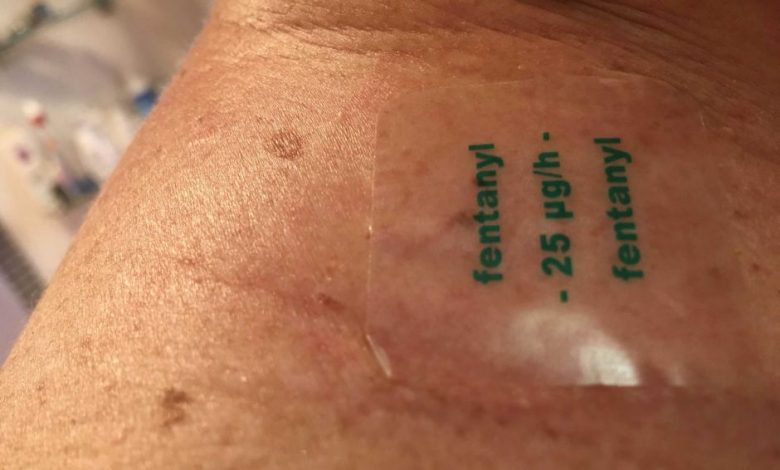Can You Lick A Fentanyl Patch?

Fentanyl patches are used to relieve severe pain in people who are expected to need pain medication around the clock for a long time and who cannot be treated with other medications. Fentanyl is in a class of medications called opiate (narcotic) analgesics. It works by changing the way the brain and nervous system respond to pain.
The use of fentanyl transdermal patches carries a number of risks of overdose, with a small margin between an appropriate therapeutic dose and a toxic dose. The use of fentanyl patches requires care when commencing treatment and is only appropriate in patients in whom opioid analgesic treatment is well established.
When fentanyl transdermal patches are used appropriately, plasma levels may take around 24 hours to reach a steady state. Fentanyl patches are designed to provide a steady release of fentanyl over 72 hours. There is no advantage in prescribing fentanyl patches to be applied daily or every two days.
Fentanyl patches may be dangerous if heat is applied to them or accidentally attached to an opioid naïve adult patient or a child. The risk of drug dependence is high when using fentanyl patches.
Fentanyl in all forms of presentation is a Schedule 2 controlled drug according to the DEA. Depending on the brand, fentanyl 100mcg / hour patches may contain up to 16.8mg of fentanyl. Significant quantities of fentanyl remain in the patches after the 72 hours transdermal application of the patch has expired.
Can you put a fentanyl patch in your mouth?
No, avoid licking or putting a fentanyl patch or the bandage that covers it in your mouth while the patch is on and for 48 hours after its removal. This medicine should only be used on skin that is not irritated or injured. Fentanyl skin patches are packaged in sealed pouches. Do not remove the patch from the sealed pouch until you are ready to apply it.
Studies have shown that there is a sufficient amount of fentanyl available for abuse and misuse after 3 days of therapeutic use. A number of deaths have been associated with the misuse of fentanyl patches, including multiple patches applied for an intoxicating effect and the injection of fentanyl extracted from fentanyl patches.
Fentanyl patches have a high illicit value and are subject to trafficking. In most countries, the main source of fentanyl patches used illicitly is from those obtained on prescription. Fentanyl patch abuse is not restricted to the streets. Recently, a nursing home aide Jeremiah J. Healless, a certified nurse assistant, was caught on camera squeezing and licking the drug out of the patch’s on the back of a defenseless 92-year-old Alzheimer patient according to the Sun-Times.
Injection of fentanyl extracted from patches has resulted in a number of overdoses, including fatal overdoses. Serious injury from the injection of fentanyl extracted from patches includes ischaemic limb injury and amputation, thrombophlebitis, and severe skin ulceration. Other serious consequences, common with injecting drug use include endocarditis, septic emboli, and osteomyelitis.
The Institute for Safe Medication Practices (ISMP) reported the incident of a child that died after gaining access to a transdermal fentanyl patch. The 15-month-old boy had been cuddling with his mother, sleeping on her chest as they both took a nap. The boy’s mother had been wearing a fentanyl patch on her chest to treat pain associated with multiple sclerosis. When the mother awoke, she found her son unresponsive. The child was rushed by ambulance to the hospital. Resuscitation efforts continued in a pediatric emergency department without success. The child’s mother noticed that the patch on her chest was missing. The baby apparently ingested the patch, although the patch was never found
Do not place patches in your mouth or chew or swallow the patches. Adequate disposal should be implemented to avoid misuse or consumption by children or pets.

How to safely use fentanyl patches
Transdermal fentanyl comes as a patch to apply to the skin. The patch is usually applied to the skin once every 72 hours. Change your patch at about the same time of day every time you change it. Follow the directions on your prescription label carefully, and ask your doctor or pharmacist to explain any part you do not understand. Apply fentanyl patches exactly as directed.
Your doctor may start you on a low-dose fentanyl patch and gradually increase your dose, not more often than once every 3 days at first, and then not more often than once every 6 days. Your doctor may decrease your dose if you experience side effects. Talk to your doctor about how you are feeling during your treatment with fentanyl patches.
Do not stop using fentanyl patches without talking to your doctor. Your doctor will probably decrease your dose gradually. If you suddenly stop using fentanyl patches you may have symptoms of withdrawal. Call your doctor if you experience any of these symptoms of withdrawal: restlessness, teary eyes, runny nose, yawning, sweating, chills, muscle pain, large pupils (black circles in the center of the eyes), irritability, anxiety, backache, pain in the joints, weakness, stomach cramps, difficulty falling asleep or staying asleep, nausea, loss of appetite, vomiting, diarrhea, fast heartbeat, or rapid breathing.
Do not use a fentanyl patch that is cut, damaged, or changed in any way. If you use cut or damaged patches, you may receive most or all of the medication at once, instead of slowly over 3 days. This may cause serious problems, including overdose and death.
You may bathe, swim, or shower while you are wearing a fentanyl patch. If the patch falls off during these activities, dispose of it properly. Then dry your skin completely and apply a new patch. Leave the new patch in place for 72 hours after you apply it.
You can apply a fentanyl patch to your chest, back, upper arms, or the sides of your waist. If you are applying the patch to a child or to a person who is unable to think clearly, choose an area on the upper back to make it more difficult for the person to remove the patch and place it in his or her mouth. Choose an area of skin that is flat and hairless. Do not apply the patch to parts of the body that move a lot or to skin that has been exposed to radiation or that is sensitive, very oily, broken out, irritated, broken, cut or damaged. If there is hair on the skin, use scissors to clip the hair as close to the skin as possible. Do not shave the area.
To apply the patch, follow these steps:
1. Clean the area where you plan to apply the patch with clear water and pat completely dry. Do not use any soaps, lotions, alcohols, or oils.
2. Tear open the pouch containing the fentanyl patch along the dotted line, starting at the slit. Remove the patch from the pouch and peel off both parts of the protective liner from the back of the patch. Try not to touch the sticky side of the patch.
3. Immediately press the sticky side of the patch onto the chosen area of skin with the palm of your hand.
4. Press the patch firmly for at least 30 seconds. Be sure that the patch sticks well to your skin, especially around the edges.
5. If the patch does not stick well or comes loose after it is applied, tape the edges to your skin with first aid tape. If the patch still does not stick well, you may cover it with Bioclusive or Tegaderm brand see-through dressings. Do not cover the patch with any other type of bandage or tape.
6. If a patch falls off before it is time to remove it, dispose of the patch properly and apply a new patch. Leave the new patch in place for 72 hours.
7. When you are finished applying the patch, wash your hands with water right away.
8. When it is time to change your patch, peel off the old patch and apply a new patch to a different skin area.
9. After you remove your patch, fold it in half with the sticky sides together and flush it down a toilet.
Frequently Asked Questions
How long does a fentanyl patch last?
A: A fentanyl patch typically lasts for three days. It is designed to provide long-acting pain relief, so it should not be changed more frequently than directed by your healthcare provider.
What happens if I leave a fentanyl patch on for too long?
A: Leaving a fentanyl patch on for too long can lead to an overdose, as the medication can accumulate in the body. It is important to follow the dosing instructions provided by your healthcare provider and to change the patch as directed.
Can a fentanyl patch be cut in half?
A: No, a fentanyl patch should not be cut or damaged in any way, as this can cause the medication to leak out and lead to an overdose. The patch should be used as directed by your healthcare provider.
Can a fentanyl patch be removed early?
A: A fentanyl patch should only be removed as directed by a healthcare provider. If you experience adverse effects, such as skin irritation or respiratory symptoms, you should seek medical attention.
How long does it take for a fentanyl patch to start working?
A: It can take up to 24 hours for a fentanyl patch to start working, as the medication needs time to be absorbed through the skin.
should I dispose of a used fentanyl patch?
A: Used fentanyl patches should be folded in half with the sticky sides together and disposed of in a sealed container, such as a plastic bag. They should be kept out of reach of children and pets and disposed of in accordance with local regulations.
Can fentanyl patches be flushed down the toilet?
A: No, fentanyl patches should not be flushed down the toilet, as this can lead to environmental contamination and pose a risk to public health. Instead, they should be disposed of in a sealed container and disposed of in accordance with local regulations.
How should I apply a fentanyl patch?
A: To apply a fentanyl patch, clean the area of skin where the patch will be placed with soap and water and allow it to dry completely. Remove the patch from its packaging and remove the protective liner. Apply the sticky side of the patch to the skin and press down firmly for 30 seconds to ensure it adheres properly.
Can I shower or swim with a fentanyl patch?
A: Yes, you can shower or swim with a fentanyl patch, as long as it is properly secured and the area around the patch is kept dry. If the patch becomes loose or falls off, you should contact your healthcare provider.
Can I wear a heating pad or use a hot tub while wearing a fentanyl patch?
A: No, you should not use a heating pad or hot tub while wearing a fentanyl patch, as this can increase the absorption of the medication and lead to an overdose. You should avoid exposing the patch to direct heat or sunlight.
Can I drive or operate heavy machinery while wearing a fentanyl patch?
A: You should use caution when driving or operating heavy machinery while wearing a fentanyl patch, as the medication can cause drowsiness and impair your ability to perform these activities safely.
Can fentanyl patches be used for recreational purposes?
A: No, fentanyl patches should not be used for recreational purposes, as they are extremely potent and can lead to addiction, overdose, and death.
What should I do if I suspect someone is overdosing on fentanyl?
A: If you suspect someone is overdosing on fentanyl, you should call 911 immediately and administer naloxone if available. You should not attempt to treat the overdose on your own.
Can fentanyl patches be used during pregnancy or breastfeeding?
A: Fentanyl patches should only be used during pregnancy or breastfeeding if the potential benefits outweigh the potential risks to the fetus or infant. It is important to discuss the risks and benefits with your healthcare provider.
Can fentanyl patches interact with other medications?
A: Yes, fentanyl patches can interact with other medications, including other opioids, benzodiazepines, and certain antidepressants. It is important to tell your healthcare provider about all medications you are taking, including over-the-counter and herbal supplements.





